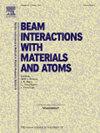Self-ion implantation using a 62Ni isotopic beam obtained with isotopic separation accomplished in a 3 MV NEC tandem accelerator
IF 1.4
3区 物理与天体物理
Q3 INSTRUMENTS & INSTRUMENTATION
Nuclear Instruments & Methods in Physics Research Section B-beam Interactions With Materials and Atoms
Pub Date : 2025-05-12
DOI:10.1016/j.nimb.2025.165738
引用次数: 0
Abstract
Self-ion irradiation has been widely used to simulate neutron damage. One issue of self-ion irradiations is the accuracy of predicted implant profiles and the associated local displacement damage. Experimental validation of ion penetration depth requires ion implantation of isotopes that are significantly low in natural abundance. Such isotopic beams are often obtained using expensive isotope-pure sputtering cathode materials. A pure Ni-62 beam can be produced from natural nickel, but effective separation requires a 90-degree bending magnet. This study demonstrates that an isotopically pure beam can be obtained using natural cathode materials with traditional small angle bending magnets. The key is to use a beam collector after the acceleration tank for mass scanning, with additional separation resolution gained from the long distance between the low-energy magnet and the beam collector. We demonstrate the feasibility of obtaining distinct peaks of Ni-58, Ni-60, Ni-61, and Ni-62 from a natural Ni cathode. Depth profiles for 2 MeV and 3.5 MeV Ni-62 ions were obtained, and show dramatic differences compared to SRIM predictions, which overestimate the ion range by ∼100% for 2 MeV and ∼30% for 3.5 MeV ions.
利用同位素分离得到的62Ni同位素束在3 MV NEC串联加速器上进行自离子注入
自离子辐照已被广泛用于模拟中子损伤。自离子辐照的一个问题是预测种植体轮廓的准确性和相关的局部位移损伤。离子穿透深度的实验验证需要离子注入天然丰度明显较低的同位素。这种同位素束通常使用昂贵的同位素纯溅射阴极材料获得。纯镍-62光束可以从天然镍中产生,但有效分离需要一个90度弯曲的磁铁。该研究表明,利用天然正极材料和传统的小角度弯曲磁体可以获得同位素纯净的束流。关键是在加速箱后使用束流收集器进行质量扫描,并从低能磁铁和束流收集器之间的长距离获得额外的分离分辨率。我们证明了从天然镍阴极获得Ni-58、Ni-60、Ni-61和Ni-62不同峰的可行性。获得了2 MeV和3.5 MeV Ni-62离子的深度分布,与SRIM预测相比存在显著差异,SRIM预测对2 MeV和3.5 MeV离子的离子范围高估了~ 100%和~ 30%。
本文章由计算机程序翻译,如有差异,请以英文原文为准。
求助全文
约1分钟内获得全文
求助全文
来源期刊
CiteScore
2.80
自引率
7.70%
发文量
231
审稿时长
1.9 months
期刊介绍:
Section B of Nuclear Instruments and Methods in Physics Research covers all aspects of the interaction of energetic beams with atoms, molecules and aggregate forms of matter. This includes ion beam analysis and ion beam modification of materials as well as basic data of importance for these studies. Topics of general interest include: atomic collisions in solids, particle channelling, all aspects of collision cascades, the modification of materials by energetic beams, ion implantation, irradiation - induced changes in materials, the physics and chemistry of beam interactions and the analysis of materials by all forms of energetic radiation. Modification by ion, laser and electron beams for the study of electronic materials, metals, ceramics, insulators, polymers and other important and new materials systems are included. Related studies, such as the application of ion beam analysis to biological, archaeological and geological samples as well as applications to solve problems in planetary science are also welcome. Energetic beams of interest include atomic and molecular ions, neutrons, positrons and muons, plasmas directed at surfaces, electron and photon beams, including laser treated surfaces and studies of solids by photon radiation from rotating anodes, synchrotrons, etc. In addition, the interaction between various forms of radiation and radiation-induced deposition processes are relevant.

 求助内容:
求助内容: 应助结果提醒方式:
应助结果提醒方式:


